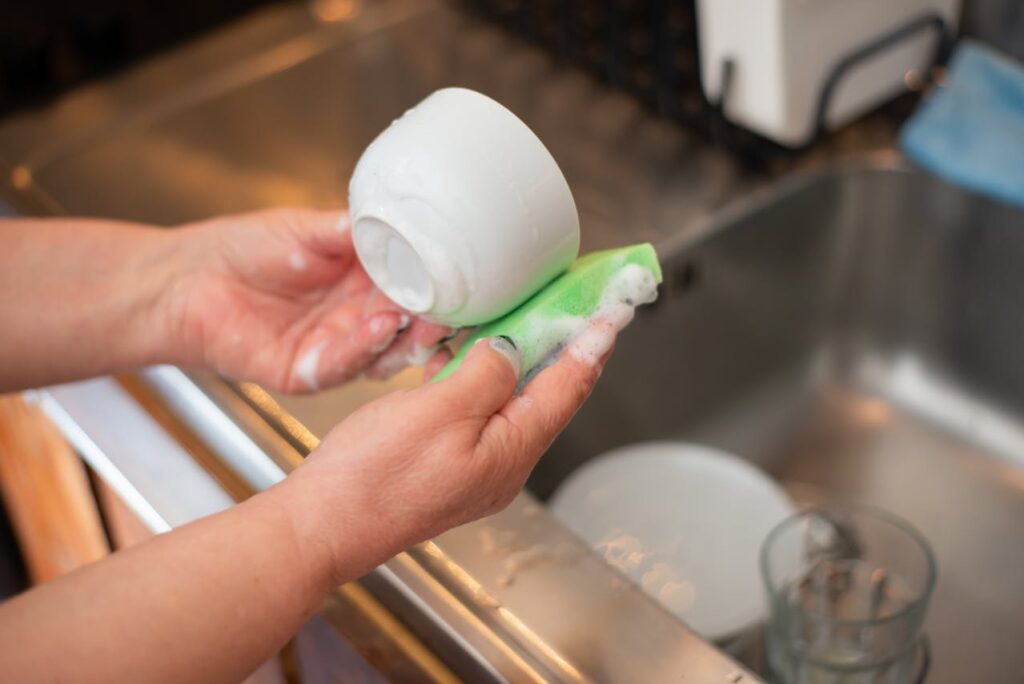In my last post, we discussed the necessity of dishwashers and why handwashing dishes can be a beneficial choice. Now, let’s talk about the simplicity of handwashing dishes.
I’ll guide you through straightforward steps and recommend tools to maintain a clean and eco-friendly kitchen. Handwashing dishes isn’t just about cleanliness. It’s also about making a sustainable choice that’s good for our environment and promotes a healthy home.
A Practical and Sustainable Approach

In many parts of the world, handwashing dishes is the most common and practical way to keep kitchens clean. Unlike dishwashers, which can be expensive and take up valuable space, most households find handwashing to be more accessible. This method is not only economical but also more sustainable.
Handwashing dishes helps conserve energy and water, as it doesn’t require electricity for operation or large amounts of water like dishwashers do. This makes it a greener choice, contributing to environmental conservation. Additionally, in regions where dishwashers are prohibitively expensive for many families, handwashing remains the preferred and affordable option.
Moreover, handwashing dishes allows for more control over cleanliness and care of kitchen items. It’s a hands-on approach that many people prefer, as it ensures thorough cleaning and immediate drying without relying on drying cycles or chemicals.
Overall, handwashing dishes is not just a practical necessity for most households around the world—it’s a sustainable choice that promotes efficiency, affordability, and environmental responsibility.
A Practical Guide to Handwashing Dishes

Washing dishes by hand is a simple yet essential task that keeps our kitchens clean and our daily routines running smoothly. Whether you’re new to handwashing or looking to refine your technique, here’s a straightforward guide to help you get the job done efficiently and effectively.
What You'll Need:
Before you begin, gather your supplies:
- Dish soap: Choose a gentle, biodegradable soap for eco-friendliness.
- Sponge or scrubber: Opt for a non-abrasive sponge or scrubber to avoid damaging dishes.
- Dish rack or towel: For drying dishes after washing, you can also use a dish rack, towel, or a drying mat.
- Hot water: Use comfortably hot water for effective cleaning.
Step-by-Step Guide:
1. Prep Your Sink

Preparing your sink is the first step to effective handwashing. First, plug the sink to retain water and prevent it from draining. The temperature of the water should be comfortably hot; this helps to dissolve grease and food residues more effectively.
Add a small amount of dish soap—about a teaspoon or as directed by the soap’s label. Additionally, it’s essential not to overdo it; too much soap can lead to excessive suds that are difficult to rinse off. The goal is to create enough suds to clean your dishes efficiently without wasting soap.
2. Sort and Rinse

Sorting your dishes before washing helps streamline the process and ensures thorough cleaning. Start by categorizing your dishes into groups such as glasses, plates, bowls, utensils, and pots or pans. This organization prevents cross-contamination and allows you to prioritize washing based on cleanliness level.
Once sorted, rinse each item under running water to remove visible food particles and debris. This step is crucial as it helps prevent food from hardening on dishes during the washing process, making them easier to clean. Use a gentle stream of water to rinse effectively without splashing or wasting water.
3. Wash

Using your sponge or scrubber, apply a small amount of dish soap to each dish and gently scrub. Begin with items that are less soiled, such as glasses and utensils, ensuring to clean both inside and outside thoroughly.
Progress to more heavily soiled items like pots and pans, then use a bit more elbow grease if necessary to remove stubborn food residue. This method ensures all dishes are cleaned effectively without risking damage to delicate surfaces or leaving behind any lingering food particles.
4. Rinse Thoroughly

After washing each dish with soap and scrubbing away food residue, it’s essential to subsequently rinse thoroughly under hot running water. This step helps to remove any remaining soap residue that could affect the taste of food or cause skin irritation.
Hot water aids in dissolving and flushing away the soap effectively. Ensure each dish is held under the running water, turning it to cover all sides and crevices, until all traces of soap are rinsed away. This ensures your dishes are not only clean but also safe and ready to use again.
5. Dry

After washing and rinsing each dish to remove soap residue, you can either place them on a dish rack for air drying or use a clean dish towel to dry them by hand. For larger dishes, some people opt to use the dishwasher as a drying rack, like my parents do.
Air drying on a dish rack promotes airflow and reduces energy use, while drying with a towel ensures dishes are immediately ready for use. Both methods maintain cleanliness and hygiene effectively.
Tips for Efficiency and Sustainability:
- Use Less Water: Fill the sink instead of letting the water run continuously.
- Save Energy: Wash dishes in batches to minimize water and energy use.
- Care for Your Tools: Rinse and air dry your sponge or scrubber after each use to prolong its life.
Why Choose Handwashing?
Handwashing dishes not only saves on energy and water consumption but also allows for greater control over cleanliness. It’s a mindful, sustainable choice that promotes a healthier environment and maintains the quality of your kitchenware.
By following these steps and tips, you can make handwashing dishes a simple and rewarding part of your daily routine. Embrace the simplicity and satisfaction of keeping your kitchen clean with your own two hands!














